|
 Bright Start Blog
|
|
Transient Art
Enabling children's creativity through movable objects by Sadiye Tosun and Mita Pandya
|
|
|
Five minute read
- What is transient art?
- What are the benefits for young children?
- How can you facilitate this type of exploration and learning in your setting?
|
|
|
Within the Early Years it’s easy to fall into the trap of focusing on the end product when providing creative activities for children. A classic example is when a set of pre-selected materials are offered and children are given instructions so the art pieces all turn out looking the same. Children can become disheartened if their work doesn’t look like a model the adult has asked them to recreate. This can be restrictive and may result in the child avoiding creative activities due to fear of failure.
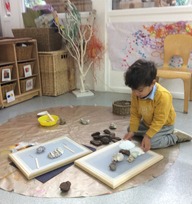
In contrast with this, transient art gives children the ability to self-select resources to create non-permanent designs. By using open ended, natural resources such as pinecones, leaves, flower petals and twigs or recyclable items such as colourful bottle tops, egg cartons and glass gems, children are empowered to explore and create with these found natural materials or loose parts. The resources can be used to create art pieces or incorporated into imaginative role play and small world storytelling. The addition of mirrors and light can provide different ways to explore transient art by creating shadows and reflections. For babies, a perfect example of transient art is heuristic play.
|
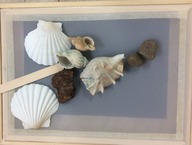
Transient art gives children the opportunity to express their ideas, go back to their creations and build on skills while learning about patterns, symmetry, shapes, space, colour, textures. There is no right or wrong way; the possibilities are endless. This enables children’s individuality to flourish and gives them a sense of control and confidence which in turn supports their wellbeing. The role of the adult is to be present with the child in the moment. By tuning into their lines of enquiry we can deepen their interests by presenting provocations of their ideas in a stimulating manner. The role is also to understand that the process of creation is crucial rather than the end product as this supports having a growth mindset.
|
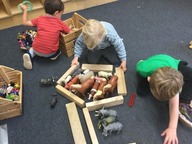
In our setting, children used the available materials to create a giant story about the gingerbread man on a very long roll of paper. They chose resources to create different characters, developed a storyline and formed letters using twigs and bark. On another occasion they created a zoo using a range of construction equipment combined with loose parts. We have found the key is to give children the opportunity to self-select resources which they then use to bring their ideas to life. Giving children the freedom to transport equipment to different areas provides them with an artistic license to explore limitless ideas through using transient materials. They discussed sizes, breeds of animals, directions, different modes of travel and how the animals were feeling. This process linked with all areas of curriculum, making it a deeply enriching learning experience. We clearly understand the importance of tuning into the children’s interests and shaping the environment according to their needs, enabling them to develop skills through repetition, scaffolding and problem solving.
|
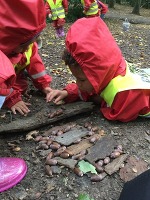
Open spaces, woods and parks are great places to collect natural materials and create transient art in situ. With space and time, children will start to explore and create. This experience gives children the opportunity to respect their environment and appreciate what is around them while being introduced to the concept of sustainability.
|
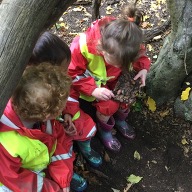
This open-ended approach to creativity is incredibly powerful for non-verbal children as it focuses on the process. They can design and create something that is meaningful to them without any pressure to verbalise their thought process. The way the children bring to life their thoughts and ideas whilst engaging in transient art is a constant source of inspiration. When provided with secure adult relationships and an enabling environment, children consistently use the resources and provocations to bring to life incredible pieces of art out of the simplest objects.
|
|
|
About the author

Sadiye Tosun is a Senior Early Years Educator and Forest School Leader working at Willow Children’s Centre in Islington. She is an ardent believer in the importance of outdoor play experiences and has witnessed first-hand the positive impact it has on children's holistic sense of wellbeing. Sadiye feels supremely lucky to work in a setting where this approach is firmly embedded into the curriculum, not only through using the nursery garden but also through planned Forest School sessions which take place at Queen's Woods. Sadiye is a passionate advocate of early years education and strongly believes that it provides a pathway for future aspirations. She always strives to deliver high quality, inclusive learning experiences where children’s interests, ideas and voices are valued.
|

Mita Pandya was born in Nairobi, Kenya and moved to London at the age of 16. She grew up with her extended family and helped look after younger cousins, which began her interest in early years education. After graduating from Roehampton Institute, Mita started her teaching career at a nursery school in Camden which is now the Coram Children’s Centre. After 10 years there, she moved to Archway Children’s Centre and has worked in Islington for the past 26 years. Mita was appointed as Head Teacher in 2016 and became Executive Head managing both Archway and Willow Children’s Centres in 2017. Mita is passionate about creating and sustaining an environment which supports children’s physical and emotional needs during their most formative years. She highly values parent partnership and a holistic approach to ensuring early intervention and positive outcomes for children and families.
|
|
|
|
|